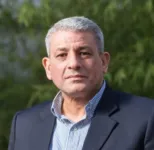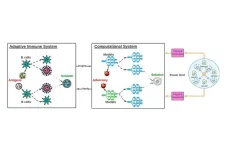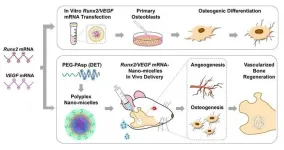(Press-News.org) In a new study published in the Proceedings of the National Academy of Sciences, authors Gabriel Gellner and Kevin McCann from the University of Guelph and SFI External Professor Alan Hastings (UC Davis) invert a classical approach to modeling food webs. Instead of trying to replicate stable, complex ecosystems using simplistic representations of species interactions, the authors’ novel inverse method assumes the ecosystems exist and works backward to characterize food webs that support that assumption. Their work represents a significant step toward addressing a fundamental ecological question of how biodiversity promotes ecosystem stability. The findings offer insights into how nature may respond to growing anthropogenic disturbances.
“Rather than start with what’s hard to measure — how species affect each other — we start with how many of each species there are and figure out how they interact in a way that explains their coexistence,” says Hastings.
Earth’s ecosystems display surprisingly stable dynamics, but attempts to understand that stability have flummoxed ecologists for generations. Lord Robert May, a past Chair of the SFI Science Board, drew from economic theory to introduce the community matrix, a mathematical tool to describe the relationships of species in an ecosystem. The matrix uses species interactions as a foundation to explain the role of diversity and complexity in ecosystem stability. The approach is useful because it considers all food web interactions; it comes up short because doing so requires overly simplistic assumptions about how organisms relate to each other. Many models based on this technique show stability decreasing as biodiversity increases, which contradicts observable stable ecosystems.
But understanding how large complex ecosystems persist is a vital question. If we fail to understand the mechanisms that stabilize ecosystems, we cannot preserve them in the face of ever-increasing chaos like severe weather events, rampaging wildfires, or rampant invasive species.
The inverse approach succeeds due to its inclusion of biological constraints in the model. A feasibility constraint dictates that only real interactions get represented in the model. Additionally, an energetic constraint stipulates that a meal cannot yield more energy than the hunt requires because, in a food chain, only 10-20% of a resource’s energy transfers to the consumer.
“We see lots of diverse ecosystems out in the world,” says Hastings. “We showed that if you put the proper biological information into the model, we can simulate large, diverse ecosystems and understand why they are stable.”
The authors highlight that the inverse approach offers major theoretical advantages over May’s classical approach, introduced more than 40 years ago. “While Robert May’s approach operated with a statistical universe…, the inverse approach has the novel property that it allows us to only look at the collection of webs corresponding to realistic feasible solutions.”
May’s community matrix catalyzed ecological theory for nearly half a century. Just as May drew from economics to rethink diversity–stability relationships, Hastings and his coauthors draw on recent efforts in genomics for inspiration. The authors believe their inverse approach is, likewise, “rich in potential for theoretical advances.”
Read the paper, "Stable diverse food webs become more common when interactions are more biologically constrained," in PNAS (July 24, 2023). doi: 10.1073/pnas.2212061120
END
Study: An inverse model for food webs and ecosystem stability
In a new study published in the Proceedings of the National Academy of Sciences, authors Gabriel Gellner and Kevin McCann from the University of Guelph and SFI External Professor Alan Hastings (UC Davis) invert a classical approach to modeling food webs
2023-07-25
ELSE PRESS RELEASES FROM THIS DATE:
New algorithm maps safest routes for city drivers
2023-07-25
Most navigation apps can show you the fastest possible route to your destination and some can even suggest an eco-friendly route calculated to produce the least amount of carbon emissions.
But what if they could also map the safest route with the lowest possible risk of a crash?
A new algorithm developed by UBC researchers could make this a reality. Led by Dr. Tarek Sayed, professor in the UBC department of civil engineering, and PhD student Tarek Ghoul, the group developed a new approach ...
Illinois Tech assistant professor receives award for using insights from human immune system to strengthen AI
2023-07-25
CHICAGO—July 25, 2023—For his groundbreaking research in fortifying artificial intelligence systems with insights gained from the human immune system, Ren Wang of Illinois Institute of Technology has received the prestigious Ralph E. Powe Junior Faculty Enhancement Award from Oak Ridge Associated Universities (ORAU). Wang’s research may be used in the future to strengthen AI systems, making them more robust and resilient.
As AI has increasingly permeated our daily lives through technologies, such as ChatGPT’s natural language ...
A novel bone regeneration technique with clinical potential
2023-07-25
Researchers from Tokyo Medical and Dental University (TMDU) identify a promising way to improve bone repair with important clinical applications
Tokyo, Japan – Although bones have the ability to regenerate and repair themselves, they are generally unable to do so when the injury is larger than a small break or chip. In a study just published in Inflammation and Regeneration, Japanese researchers have developed a technique for improving bone regeneration over large areas in rats—and their findings may translate well to clinical settings.
As most of us know from experience, bones can repair themselves after a minor break ...
Researchers detail methodological approach to creating joint displays of data collection in mixed methods research
2023-07-25
Researchers present a methodology for developing joint displays of integrated mixed data collection. These joint displays provide a framework for supporting integration of a mixed methodology in research. Drawing upon a convergent mixed methods cohort study – the Early Discharge of Febrile Neutropenic Children with Cancer Study – the authors constructed a joint display of integrated mixed data collection from a patient/caregiver mixed methods survey instrument and manual medical chart abstraction. The paper outlines the methodological approach, including iterative ...
Brazilian researchers identify gynecological concerns of caregivers of young girls and women with Down syndrome
2023-07-25
Brazilian researchers conducted a cross-sectional study to explore the concerns of caregivers of Brazilian girls with Down syndrome (DS) regarding gynecological aspects of DS including menstruation, contraception and sexual practices. The study included 100 caregivers of females aged 9 years or older with DS who had reached menarche. Participating caregivers completed a questionnaire about their concerns around puberty, menstruation, sexuality and contraceptive methods.
Caregivers commonly expressed concerns around menstrual bleeding. Most caregivers ...
Meta-analysis of research on acne reveals that oral isotretinoin, followed by topical antibiotic, benzoyl peroxide and retinoid, are most effective treatments
2023-07-25
In their comprehensive meta-analysis (comprising 221 randomized controlled trials involving 65,601 patients), researchers investigated the effectiveness of various pharmacological therapies for acne vulgaris across diverse age groups and genders. The articles described 37 interventions, with a median patient age of 20 years old and median duration of treatment of 12 weeks. The median total, inflammatory and non-inflammatory lesion counts were 71.5, 27 and 44, respectively.
The study revealed that oral isotretinoin was the most effective treatment (mean difference 48.41; p-score 1.00), followed in efficacy by a triple therapy containing ...
Survey suggests geographic inequalities in patient registration versus primary care physician density can exclude patients from comprehensive care access
2023-07-25
French researchers conducted a large, simulated study to examine the relationship between the presence of primary care physicians (PCPs) and the ability of patients to register with a PCP. The study aimed to analyze local PCP supply based on various indicators, including PCP presence, patient registration availability for office visits, and patient registration availability for home visits. Out of 5,188 census blocks, 55.4% had at least one PCP, with 38.6% of those blocks allowing registration for office visits and 19.46% allowing registration for home ...
Greater primary care continuity among older people is associated with fewer inappropriate prescriptions and prescribing omissions
2023-07-25
Researchers from the Netherlands conducted an observational study to determine the association between personal continuity and potentially inappropriate prescriptions (PIPs) by family physicians in older patients. PIPs can be categorized as potentially inappropriate medications (PIMs) and potential prescribing omissions (PPOs). The study utilized anonymized routine care data from 269,478 patients, receiving care in 48 Dutch family practices, from 2013 to 2018. They included all patients 65 and older with five or more contacts with their practice in six years, giving them a sample of 25,854 individuals. ...
Primary care clinics that improved patient access, identified at-risk patients and expanded services experienced reductions in acute hospitalizations
2023-07-25
Researchers from Mathematica studied high-performing Comprehensive Primary Care Plus (CPC+) sites to identify key strategies that contributed to significant reductions in acute hospitalization rates. Researchers identified CPC+ practice sites with the highest likelihood of achieving substantial reductions in Medicare acute hospitalization rates between 2016 and 2018, and referred to them as "Acute Hospitalization Rate (AHR) high-performers." Afterwards, they conducted telephone interviews and within- and cross-case comparative analyses of 14 of these primary care practice sites, ...
Primary care doctors face barriers in treating alcoholism
2023-07-25
Researchers explored how primary care physicians who have some familiarity with medications for alcohol use disorder (MAUD) make prescribing decisions and identify reasons for the underuse of MAUD in primary care. They interviewed 19 primary care physicians who had recently prescribed MAUD to patients in an outpatient setting. These physicians were selected from a large online database of medical professionals. Participating physicians reported several challenges in prescribing MAUD: (1) they had somewhat negative personal beliefs about the effectiveness of medications and the likelihood of patient ...
LAST 30 PRESS RELEASES:
Autistic and non-autistic faces may “speak a different language” when expressing emotion
No clear evidence that cannabis-based medicines relieve chronic nerve pain
Pioneering second-order nonlinear vibrational nanoscopy for interfacial molecular systems beyond the diffraction limit
Bottleneck in hydrogen distribution jeopardises billions in clean energy
Lung cancer death rates among women in Europe are finally levelling off
Scientists trace microplastics in fertilizer from fields to the beach
The Lancet Obstetrics, Gynecology, & Women’s Health: Taking paracetamol during pregnancy does not increase risk of autism, ADHD or intellectual disabilities, confirms new gold-standard evidence review
Taking paracetamol during pregnancy does not increase risk of autism, ADHD or intellectual disabilities
Harm reduction vending machines in New York State expand access to overdose treatment and drug test strips, UB studies confirm
University of Phoenix releases white paper on Credit for Prior Learning as a catalyst for internal mobility and retention
Canada losing track of salmon health as climate and industrial threats mount
Molecular sieve-confined Pt-FeOx catalysts achieve highly efficient reversible hydrogen cycle of methylcyclohexane-toluene
Investment in farm productivity tools key to reducing greenhouse gas
New review highlights electrochemical pathways to recover uranium from wastewater and seawater
Hidden pollutants in shale gas development raise environmental concerns, new review finds
Discarded cigarette butts transformed into high performance energy storage materials
Researchers highlight role of alternative RNA splicing in schizophrenia
NTU Singapore scientists find new way to disarm antibiotic-resistant bacteria and restore healing in chronic wounds
Research suggests nationwide racial bias in media reporting on gun violence
Revealing the cell’s nanocourier at work
Health impacts of nursing home staffing
Public views about opioid overdose and people with opioid use disorder
Age-related changes in sperm DNA may play a role in autism risk
Ambitious model fails to explain near-death experiences, experts say
Multifaceted effects of inward foreign direct investment on new venture creation
Exploring mutations that spontaneously switch on a key brain cell receptor
Two-step genome editing enables the creation of full-length humanized mouse models
Pusan National University researchers develop light-activated tissue adhesive patch for rapid, watertight neurosurgical sealing
Study finds so-called super agers tend to have at least two key genetic advantages
Brain stimulation device cleared for ADHD in the US is overall safe but ineffective
[Press-News.org] Study: An inverse model for food webs and ecosystem stabilityIn a new study published in the Proceedings of the National Academy of Sciences, authors Gabriel Gellner and Kevin McCann from the University of Guelph and SFI External Professor Alan Hastings (UC Davis) invert a classical approach to modeling food webs




